The 11 Best Resources for Learning Japanese
I have been learning Japanese a long time. I studied it formally at
university and came out without any capacity to communicate in
Japanese. I half blame the teachers who were better at researching
linguistics than teaching it coherently (typically class activity was
watching an episode of Aguri
and cramming its archaic vocabulary), but I do blame myself for being a
lazy student and believing that because I was paying for a uni course, I
would just passively absorb language competency.
Living in Japan certainly helps learning it but, like university, you can’t sit around waiting for the moment everything becomes comprehensible. Having good resources is a must. There are books I’ve picked up, such as Read Japanese Today which, to me, were a waste of time with a catchy name.
So to save you time, instead of scouring the tubes fruitlessly (I’ve done it for you over years and years) instead of study, compiled a list of the 10 best resources I’ve found for learning Japanese.
Software
Z-kanji:
The most useful dictionary I have ever known. No longer do you need to memorise the ‘dictionary form’ of verbs because you can enter verbs in ANY form: passive, negative, causative, past, present ANYTHING and Zkanji will produce a handy list of results and what it could mean. I also love the kanji stroke order animation. Best of all, Zkanji is FREE and frequently updated.
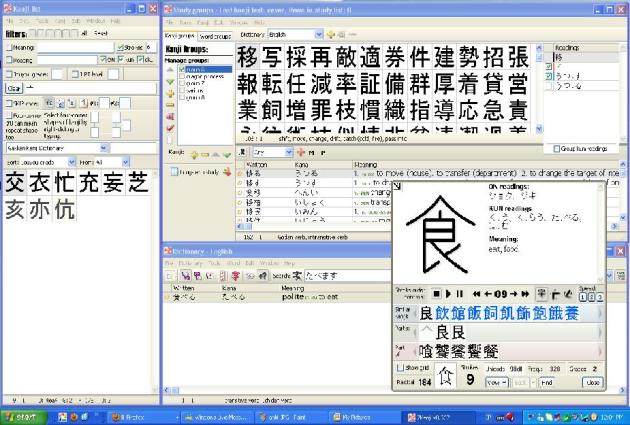
Anki:
Another open-source, free study gem. Anki is a flashcard program which quizzes you at varying levels of frequency depending on how well you know a card. You can download ready made decks for a staggering variety of subjects including Japanese or biology (even guitar tabs apparently). I don’t take advantage of all the features, like audio or video clips but I find it fantastically useful for my vocab and grammar cards and in conjunction with a bit of scrap paper and a pencil for revising kanji.
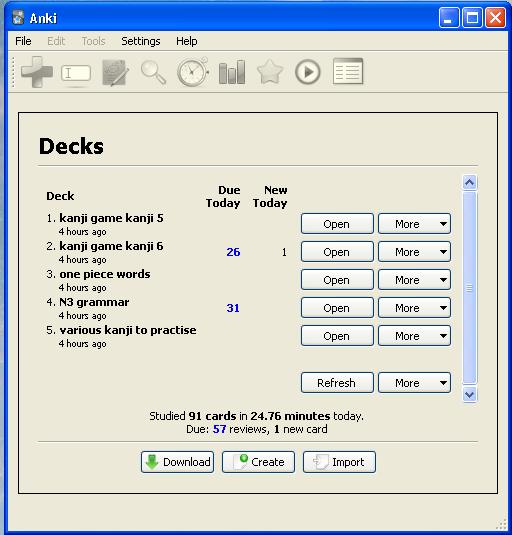
Kanjilab:
Great drill program for kanji. Using the “Reading” function, you learn all the different readings, both on and kun, and slowly rise up the mastery levels unlocking 10 new kanji each time. Click ‘Sentences’ to see the words in context and apply your skills in the “Fill In” exercise. Though it hasn’t been updated since 2004, this is still a very useful and pretty stable, free program.

Rikaichan
An add-on rather than a program, but soooo handy to have when reading Japanese online. For example, when reading this story from Asahi.com, Rikaichan deciphers word you can then chuck into Anki for later revision.

Online:
There are lots of great communities online, I’ve heard readthekanji.com is pretty good, but I find sometimes find it difficult to continue with a particular website’s regime, even after going to the effort of setting up a profile. Sometimes, instead of logging in, going through the forgotten password recovery rigmarole, and then getting sidetracked and checking on my Facebook, I just want to do some practice or get some knowledge straight up. Here are the sites I’ve found most useful.
Tae Kim:
This is an amazing resource full of clearly explained wealth of grammar information, exercises and tutorials plus a forum for the twisty questions.
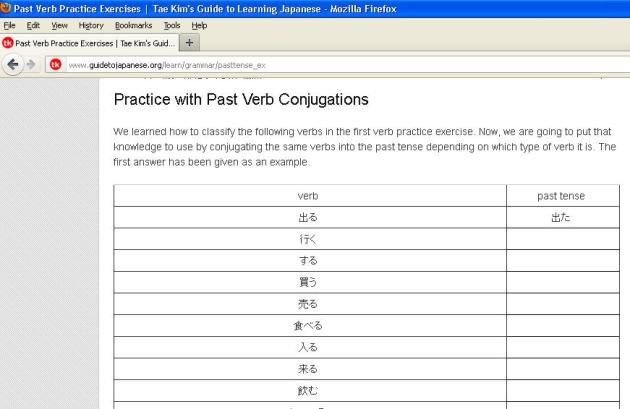
Mic-J: Thank you Tokyo Metropolitan University for making this. Interactive listening quizzes aimed at the different JLPT levels, interviews, grammar explanations. Fantastic for sharpening up listening skills especially for those not in Japan.

U-biq:
A comprehensive bank of online tests that give you a score and direct you to ‘refresher lessons’ for those questions you fail at.
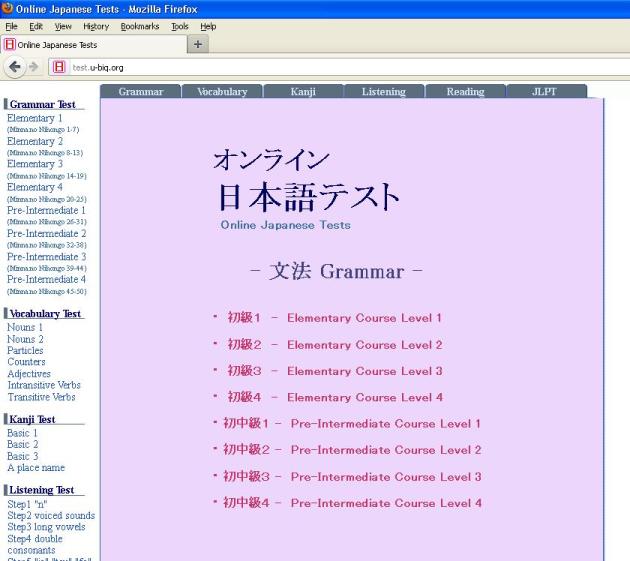
If you go to the main homepage there are a lot of other JLPT related resources too, but which I haven’t really delved into much yet.
Community:
Ok, despite my earlier comments joining some online communities can be helpful. The two sites below are great because you can directly interact with native speakers.
Lang-8
Lang-8 is great. It shows how powerful the internet can be when people pool their skills together in a supportive and positive way. The basic idea is to write something – anything – a blog, a diary, sentences for Japanese homework, whatever! And native speakers will correct them for you, surprisingly quickly. You, being a good community member, will return the favour, if not for your ‘friends’ then for someone else, keeping the system chugging along.
SharedTalk by Rosetta Stone:
Sharedtalk is a bit of a mixed bag. In many ways it’s fantastic: linking native speakers of different languages together in text chat or, for the braver, voice chat. The quality of chat is usually pretty good, I haven’t talked to any trolls or other cyber-harrassers. For the real shrinking daisies you can just mail each other. The main problems I’ve had with SharedTalk are more that people tend to chat in English rather than sharing time and don’t correct mistakes (kind of like real life language exchange). Setting out the parameters in a private conversation straight up can keep the things relevant.
I’ve tried using RWorld (see bottom left big, blue button) which is meant to connect users in various language learning games, but no one is ever on.
Books:
You know, books? The things not on the computer? Despite living most of my life online, I have still collected an impressive amount of textbooks. Highly rated books like Kanzen Master have been little help to me. Reading over lists of grammar and a few sentences never feels like it cements their usage in my mine. I need a variety of exercises and challenges to do that and one series in particular provided them.
Minna no nihongo:
Ok, the guy probably makes a lot of money if you decide to buy the Japanese book, plus the translation and the listening CDs book and the workbook all separately BUT there is so much in them, explanations, reading exercises, revising grammar from earlier chapters – you probably won’t even need another textbook, especially for beginners to intermediate.
And finally, the most useful study tool in my repotoire:
The Nintendo DS
From beginner to advanced, the DS has the software for learning and using Japanese. Having a stylus for writing in kanji in the dictionary or quiz games means a more interactive study experience. No region lock means that games released in Japan that were intended for Japanese learners can be bought and played on consoles in other coutries.
I’m going to cheat a bit with the numbers and smush the three DS games I use most during study into one big DS category:
Kanji Sonomama Rakubiki Jiten:
Link is to a very handy Youtube video which is explain this great program way better than I, but basically it’s an electronic dictionary English to Japanese and visa versa, where you search for a word in English, kana or kanji, using the stylus to write it in. It doesn’t have Oxford English dictionary level of entries, but since I got this program, my very expensive Word-tank electronic dictionary has been ignored.
Bimoji training
This game needs a walk-through Youtube video like the one above, or else it maybe difficult for beginners to access. This is a game aimed squarely at the domestic Japanese market, for those embarrassed by their less than beautiful kanji writing.

The top, blue outlined menu button is a lite-version of the game with an explanation and aptitude test.
The next button is “Everyday Training”. You make your profile, click on the big red button marked トレーニング and get a go at drawing some kanji.
You may not understand the detailed explanation of what you did wrong, but it’s good practice for correct stroke order. Once you’re through the Daily Exercise, you can access a function I really like: Personal practise. 自由に練習 Small, dark green button at the bottom.

Here you can add what kanji you specifically want to get down the right way.
Ok, best for last:
250 Mannin no Kanken
Some lovely chap has done a video for the previous 200 Mannin no Kanken, but as far as I can tell, there is no difference.
The reasons I love this game are:
The levels. From 10, with the first kanji kids in grade 1 learn, to SPECIAL LEVEL 1 which even native speakers are challenged by. You can practice both writing and reading of kanji and test your overall ability. Each quiz is only 5 questions (or 2 minutes) long, so you can study in quick bursts.
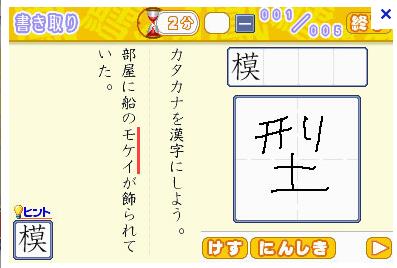
The word is in context: On the left (or right if you’re left handed) is a bit of flavour-text, with the red highlighting the word you have to write. There is more than one sentence for the kanji, so you don’t get too comfortable just learning how to recognise a certain phrase.
Hints, Revision and Testing Only of Weak Kanji: As you can see in the bottom left corner of the photo, the game eventually will give you a hint (or the whole kanji) when you’re struggling. At the end of each quiz there is the option to go through and revise each kanji, maybe take some time to enter the tricky ones into Anki. There’s also an option to only quiz the kanji you got wrong, which is great for the beginning of a new, higher level when you want to take things slow, absorb and not continually experience the sting of failure.
Orbs: Achieving Rainbow orb on a new level is such a rush~
Don’t be too frustrated if the game spits out the wrong kanji, even when you wrote it down perfectly. It can be quite strict with stroke order, but it only took a short amount of playing until I got the hang of it.
So there you go. 11 (remember DS games = one category ) hopefully useful resources for studying Japanese.
) hopefully useful resources for studying Japanese.
I’m always keen to hear other people’s study tips and resources so please feel free to comment.
Living in Japan certainly helps learning it but, like university, you can’t sit around waiting for the moment everything becomes comprehensible. Having good resources is a must. There are books I’ve picked up, such as Read Japanese Today which, to me, were a waste of time with a catchy name.
So to save you time, instead of scouring the tubes fruitlessly (I’ve done it for you over years and years) instead of study, compiled a list of the 10 best resources I’ve found for learning Japanese.
Software
Z-kanji:
The most useful dictionary I have ever known. No longer do you need to memorise the ‘dictionary form’ of verbs because you can enter verbs in ANY form: passive, negative, causative, past, present ANYTHING and Zkanji will produce a handy list of results and what it could mean. I also love the kanji stroke order animation. Best of all, Zkanji is FREE and frequently updated.

Anki:
Another open-source, free study gem. Anki is a flashcard program which quizzes you at varying levels of frequency depending on how well you know a card. You can download ready made decks for a staggering variety of subjects including Japanese or biology (even guitar tabs apparently). I don’t take advantage of all the features, like audio or video clips but I find it fantastically useful for my vocab and grammar cards and in conjunction with a bit of scrap paper and a pencil for revising kanji.

Kanjilab:
Great drill program for kanji. Using the “Reading” function, you learn all the different readings, both on and kun, and slowly rise up the mastery levels unlocking 10 new kanji each time. Click ‘Sentences’ to see the words in context and apply your skills in the “Fill In” exercise. Though it hasn’t been updated since 2004, this is still a very useful and pretty stable, free program.

Rikaichan
An add-on rather than a program, but soooo handy to have when reading Japanese online. For example, when reading this story from Asahi.com, Rikaichan deciphers word you can then chuck into Anki for later revision.

Online:
There are lots of great communities online, I’ve heard readthekanji.com is pretty good, but I find sometimes find it difficult to continue with a particular website’s regime, even after going to the effort of setting up a profile. Sometimes, instead of logging in, going through the forgotten password recovery rigmarole, and then getting sidetracked and checking on my Facebook, I just want to do some practice or get some knowledge straight up. Here are the sites I’ve found most useful.
Tae Kim:
This is an amazing resource full of clearly explained wealth of grammar information, exercises and tutorials plus a forum for the twisty questions.

Mic-J: Thank you Tokyo Metropolitan University for making this. Interactive listening quizzes aimed at the different JLPT levels, interviews, grammar explanations. Fantastic for sharpening up listening skills especially for those not in Japan.

U-biq:
A comprehensive bank of online tests that give you a score and direct you to ‘refresher lessons’ for those questions you fail at.

If you go to the main homepage there are a lot of other JLPT related resources too, but which I haven’t really delved into much yet.
Community:
Ok, despite my earlier comments joining some online communities can be helpful. The two sites below are great because you can directly interact with native speakers.
Lang-8
Lang-8 is great. It shows how powerful the internet can be when people pool their skills together in a supportive and positive way. The basic idea is to write something – anything – a blog, a diary, sentences for Japanese homework, whatever! And native speakers will correct them for you, surprisingly quickly. You, being a good community member, will return the favour, if not for your ‘friends’ then for someone else, keeping the system chugging along.
SharedTalk by Rosetta Stone:
Sharedtalk is a bit of a mixed bag. In many ways it’s fantastic: linking native speakers of different languages together in text chat or, for the braver, voice chat. The quality of chat is usually pretty good, I haven’t talked to any trolls or other cyber-harrassers. For the real shrinking daisies you can just mail each other. The main problems I’ve had with SharedTalk are more that people tend to chat in English rather than sharing time and don’t correct mistakes (kind of like real life language exchange). Setting out the parameters in a private conversation straight up can keep the things relevant.
I’ve tried using RWorld (see bottom left big, blue button) which is meant to connect users in various language learning games, but no one is ever on.
Books:
You know, books? The things not on the computer? Despite living most of my life online, I have still collected an impressive amount of textbooks. Highly rated books like Kanzen Master have been little help to me. Reading over lists of grammar and a few sentences never feels like it cements their usage in my mine. I need a variety of exercises and challenges to do that and one series in particular provided them.
Minna no nihongo:
Ok, the guy probably makes a lot of money if you decide to buy the Japanese book, plus the translation and the listening CDs book and the workbook all separately BUT there is so much in them, explanations, reading exercises, revising grammar from earlier chapters – you probably won’t even need another textbook, especially for beginners to intermediate.
And finally, the most useful study tool in my repotoire:
The Nintendo DS
From beginner to advanced, the DS has the software for learning and using Japanese. Having a stylus for writing in kanji in the dictionary or quiz games means a more interactive study experience. No region lock means that games released in Japan that were intended for Japanese learners can be bought and played on consoles in other coutries.
I’m going to cheat a bit with the numbers and smush the three DS games I use most during study into one big DS category:
Kanji Sonomama Rakubiki Jiten:
Link is to a very handy Youtube video which is explain this great program way better than I, but basically it’s an electronic dictionary English to Japanese and visa versa, where you search for a word in English, kana or kanji, using the stylus to write it in. It doesn’t have Oxford English dictionary level of entries, but since I got this program, my very expensive Word-tank electronic dictionary has been ignored.
Bimoji training
This game needs a walk-through Youtube video like the one above, or else it maybe difficult for beginners to access. This is a game aimed squarely at the domestic Japanese market, for those embarrassed by their less than beautiful kanji writing.

Could use Sonomama Rakubiki Jitenon a second Nintendo DS to decipher it.http://ascii.jp/elem/000/000/136/136953/img.html
The next button is “Everyday Training”. You make your profile, click on the big red button marked トレーニング and get a go at drawing some kanji.
You may not understand the detailed explanation of what you did wrong, but it’s good practice for correct stroke order. Once you’re through the Daily Exercise, you can access a function I really like: Personal practise. 自由に練習 Small, dark green button at the bottom.

Here you can add what kanji you specifically want to get down the right way.
Ok, best for last:
250 Mannin no Kanken
Some lovely chap has done a video for the previous 200 Mannin no Kanken, but as far as I can tell, there is no difference.
The reasons I love this game are:
The levels. From 10, with the first kanji kids in grade 1 learn, to SPECIAL LEVEL 1 which even native speakers are challenged by. You can practice both writing and reading of kanji and test your overall ability. Each quiz is only 5 questions (or 2 minutes) long, so you can study in quick bursts.

The word is in context: On the left (or right if you’re left handed) is a bit of flavour-text, with the red highlighting the word you have to write. There is more than one sentence for the kanji, so you don’t get too comfortable just learning how to recognise a certain phrase.
Hints, Revision and Testing Only of Weak Kanji: As you can see in the bottom left corner of the photo, the game eventually will give you a hint (or the whole kanji) when you’re struggling. At the end of each quiz there is the option to go through and revise each kanji, maybe take some time to enter the tricky ones into Anki. There’s also an option to only quiz the kanji you got wrong, which is great for the beginning of a new, higher level when you want to take things slow, absorb and not continually experience the sting of failure.
Orbs: Achieving Rainbow orb on a new level is such a rush~
Don’t be too frustrated if the game spits out the wrong kanji, even when you wrote it down perfectly. It can be quite strict with stroke order, but it only took a short amount of playing until I got the hang of it.
So there you go. 11 (remember DS games = one category
I’m always keen to hear other people’s study tips and resources so please feel free to comment.





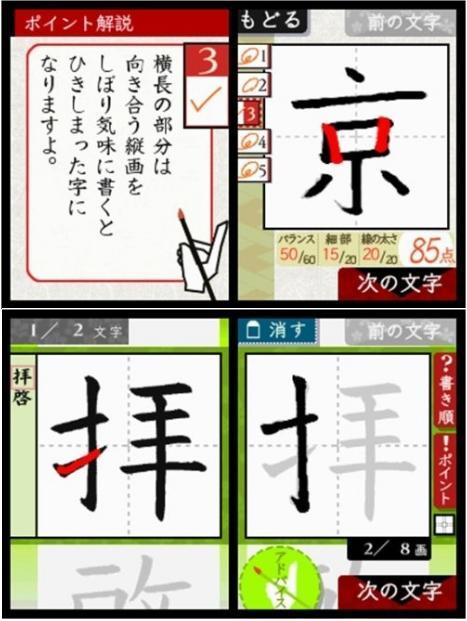
0 komentar:
Posting Komentar